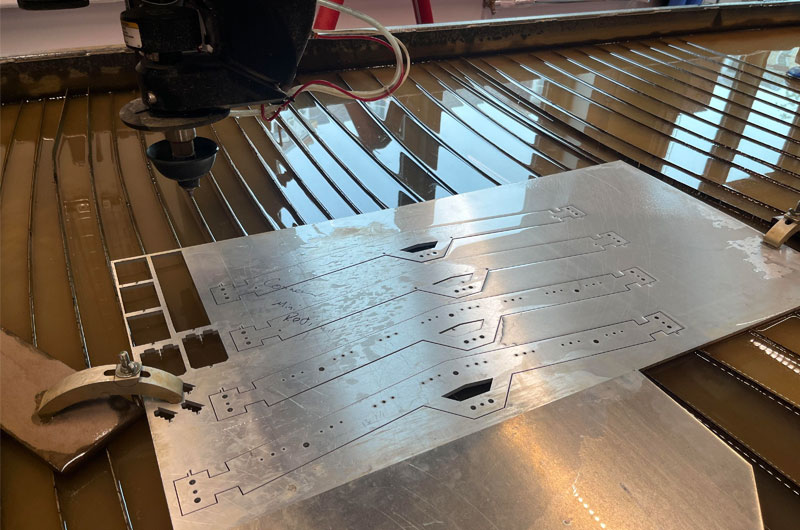Flatness is a fundamental property of sheet metal that plays a critical role in the success of cutting operations. Whether using laser, plasma, waterjet, or mechanical shearing methods, the degree of flatness significantly affects precision, efficiency, product quality, and overall manufacturing costs.
Now, we explore why flatness matters in sheet metal cutting, the consequences of poor flatness, and how to control and correct flatness issues in industrial settings.
What Is Flatness in Sheet Metal?
Flatness refers to the degree to which the surface of a sheet metal lies in a single plane without significant waviness, warping, bowing, or distortion. It is different from thickness or straightness; flatness specifically pertains to the sheet’s surface geometry and its deviation from a perfectly flat surface.
Industry standards such as ASTM A568 and ISO 2768 define acceptable flatness tolerances for sheet metal depending on the material type, thickness, and intended use.
Why Flatness Matters
1. Cutting Accuracy and Dimensional Tolerance
Flat sheets allow cutting tools—whether a laser beam or a mechanical punch—to maintain consistent focus and positioning. Uneven surfaces can result in:
- Inconsistent kerf width: Variations in material height can affect laser focus and change the cut width.
- Misalignment and deviation: CNC-guided machines rely on a stable reference plane; warping can shift the cutting path.
- Reduced repeatability: Flatness issues cause variability from part to part, especially in high-volume production.
2. Machine Performance and Tool Wear
A non-flat sheet introduces unpredictable gaps or resistance, which stresses both the machine and the cutting tool. This can lead to:
- Increased wear and tear on nozzles, blades, or abrasive heads.
- Frequent recalibration of height control systems.
- Unexpected machine downtime due to jamming or errors.
For CNC laser cutting machines equipped with automatic height control, warped sheets can still cause interruptions if the variation exceeds the sensor’s adjustment range.
3. Material Handling and Fixturing
Flat sheets are easier to handle and secure. In contrast, bowed or twisted sheets may:
- Require additional clamping, suction, or fixturing.
- Delay loading and unloading times.
- Cause stack instability, especially in automated sheet feeders.
Poor flatness disrupts the entire flow of production—cutting, forming, welding, and assembly—because each process expects parts with predictable geometry.
4. Post-Cutting Processes and Assembly Fit
Downstream operations like bending, welding, and surface finishing rely on tight tolerances. Flatness inconsistencies can lead to:
- Poor part fit in assemblies.
- Increased rework or scrap due to mismatched or distorted components.
- Difficulties in coating or painting, as uneven surfaces may trap contaminants or lead to uneven finish.
For industries like aerospace, automotive, and electronics, even minor deviations in flatness can compromise functional performance or safety.
Common Causes of Poor Flatness
Several factors contribute to sheet metal distortion before and during cutting:
- Residual stress from rolling or previous processing.
- Improper storage leading to sagging or bending.
- Thermal distortion during laser or plasma cutting.
- Mechanical stress from clamping or fixturing.
Certain materials, such as aluminum and stainless steel, are more susceptible to warping because of their high thermal conductivity and elastic characteristics.
Controlling and Correcting Flatness in Practice
1. Material Selection and Certification
Start by sourcing high-quality materials with certified flatness tolerances. Material suppliers can often provide levelled sheets or cut-to-size blanks that meet tighter specifications.
2. Proper Storage and Handling
- Store sheets horizontally on flat, supported surfaces.
- Use protective spacers and avoid leaning sheets vertically.
- Handle sheets carefully to prevent bending or denting.
3. Leveling and Flattening Equipment
For large production runs, metal service centers and fabricators often use roller levelers or flattening machines to remove internal stresses and achieve uniform flatness before cutting.
4. Cutting Method Optimization
- Use height control systems in laser or plasma cutters.
- Minimize heat input to reduce thermal distortion.
- Apply cutting strategies (e.g., sequence optimization) that prevent localized heat buildup.
5. Inspection and Quality Control
After cutting, use tools like flatness gauges, coordinate measuring machines (CMM), or laser scanners to inspect critical dimensions and confirm flatness tolerances.
Industries Where Flatness Is Critical
Certain sectors demand extreme flatness due to the tight tolerances required:
- Aerospace: Structural components must align perfectly to ensure aerodynamic and load-bearing performance.
- Electronics: Enclosure panels and heat sinks require flat mounting surfaces for thermal and mechanical reliability.
- Automotive: Chassis and body panels must fit precisely in robotic assembly lines.
- Medical devices: High-precision components require geometrical accuracy for safety and regulatory compliance.

